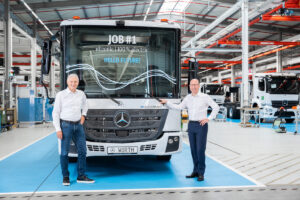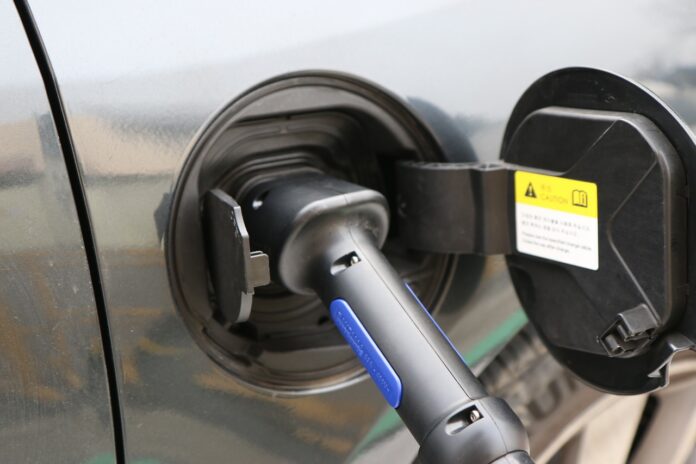 Daimler Truck is accelerating the electrification of its vehicle fleet: The Mercedes-Benz eEconic for municipal use is going into series production at the Wörth site in the southern Rhineland-Palatinate. Within a short period of time, the second model of the battery-electric Mercedes-Benz trucks will roll off the production line in Wörth, following the series launch of the eActros for urban distribution transport in October 2021. The eEconic was developed together with customers and, following intensive test series, has been undergoing practical trials with customers since May 2022. The first vehicle from series production will be handed over to Urbaser A/S, a company operating in the waste disposal sector in Denmark. Other customers have already opted for the series-production eEconic. The vehicles are to be delivered successively over the course of the year.
Daimler Truck is accelerating the electrification of its vehicle fleet: The Mercedes-Benz eEconic for municipal use is going into series production at the Wörth site in the southern Rhineland-Palatinate. Within a short period of time, the second model of the battery-electric Mercedes-Benz trucks will roll off the production line in Wörth, following the series launch of the eActros for urban distribution transport in October 2021. The eEconic was developed together with customers and, following intensive test series, has been undergoing practical trials with customers since May 2022. The first vehicle from series production will be handed over to Urbaser A/S, a company operating in the waste disposal sector in Denmark. Other customers have already opted for the series-production eEconic. The vehicles are to be delivered successively over the course of the year.
«From the sketch to the finished vehicle, from the prototype to the production truck – now the time has come: with the eEconic, we are putting the first electrically powered and series-produced Mercedes-Benz Special Truck on the road. The exchange with our customers has shown: cities and municipalities want CO2-neutral vehicles for their fleets. Especially with regard to large cities, there is a need for quiet, clean and safe logistics and waste disposal solutions. And we offer just the right truck for this» said Dr. Ralf Forcher, Head of Mercedes-Benz Special Trucks.
The eEconic will be manufactured in the existing Mercedes-Benz Special Trucks assembly line, in parallel and flexibly alongside the trucks that will be powered by internal combustion engines. After the vehicle has been largely assembled, the eEconic’s electrification continues in the Future Truck Center, where – just like the eActros – it is equipped with the electric drive components. In several production steps, the high-voltage batteries and the charging unit are installed, among other things. Once all high-voltage components have been assembled, the entire system can be put into operation and the truck is ready to drive.
The key technical specifications of the eEconic are largely identical to those of the eActros. The eEconic as a waste collection is designed to cover the vast majority of typical waste collection routes operated by an Econic in a single shift without intermediary charging. The electric drivetrain enables a level cab floor to be implemented – this facilitates moving through the cab and is particularly advantageous when the driver wishes to leave the vehicle through the folding door on the co-driver’s side, well out of the way of the traffic.
Electrification of heavy vehicles: the race of Daimler Truck

Growths up to almost 100% The race of electric motorbikes goes on

Last August, the Italian Association Ancma – National Association of Bicycles, Motorbikes and Accessories has cast its spotlights on the market of two-wheeled motor vehicles in Italy. Global provisioning problems overall weaken vehicles’ availability, whereas the annual cumulative is stable. In a scenario where the global registrations of mopeds, scooters and motorcycles in July are affected by the 7% downturn versus the same 2021-month, it goes on the race of electric vehicles that, in July, grow by 79.4% and achieve 2,184 units. The yearly cumulative trend was similar, with 11,356 vehicles placed on the market, corresponding to the 81.7% growth. Particularly lively the segment of scooters that, with 6,644 units, grazes the doubling versus the previous year (+97.4%).
Permanent magnets, a deal worth 917 million dollars
Korean Posco International has secured two contracts worth a total of $917 million with global automakers. The company’s US subsidiary will supply permanent magnets to an undisclosed US automaker, a contract valued at 900 billion won.
These magnets will be used to manufacture motor cores for the automaker’s new mid-sized EVs from 2026 to 2031. Posco International will source the rare earth metals required for the magnets from the United States, Australia, and Vietnam. This is significant as China currently controls 90% of the rare earth metals market.
The company has also announced plans to construct two additional EV motor core plants in Poland and Mexico. This will bring the total number of Posco’s plants to five, with existing facilities in Korea, Mexico, Poland, India, and China.
Rare earths, crackdown on exports from China?
The latest rumours from the market suggest that China is considering – to safeguard the “national safety” – to forbid the export of the rare earths used to manufacture high-performance magnets used for the production of electric motors and wind-turbine motors.
The Serbian expert Goran Janjic, Sustainability and Business Strategist explained: “With the global trend toward decarbonization driving a shift toward the use of electric motors, China is believed to be seeking to seize control of the magnet supply chain and establish dominance in the burgeoning environment sector”.
Beijing is currently in the process of revising its Catalogue of Technologies Prohibited and Restricted from Export, a list of manufacturing and other industrial technologies subjected to export controls, and released a draft of the revised catalogue for public comment in December.
“China is estimated to hold an about 84% share of the global market in neodymium magnets and an over 90% interest in samarium cobalt magnets. Japan, meanwhile, has about 15% of the neodymium magnet market and a less-than-10% share of that for samarium cobalt. If China bans the export of such technologies, it would be difficult for the United States and Europe, which do not traditionally manufacture rare earth magnets, to newly enter the market, thus making those countries totally dependent on China, according to a European source”.
Electric air taxi for urban transport
Good news from Volocopter, German company that for a long time now has designed and implemented aircrafts for urban mobility. The news concerns the VoloConnect solution, a new aircraft characterized by vertical take-off and landing system, an eVTOL designed to move comfortably in cities during next years.
It is not the first prototype of this kind that promises changing deeply the mobility of the future, but VoloConnect seems to have a capacity of travelling on longer distances, to operate as an electric taxi beyond the urban ambit, too.
VoloConnect could, in fact, transport up to four passengers, with an autonomy of about 100 kilometres, at a speed of 180 Km/h, with a maximum speed that could reach about 250 Km/h.
After two years of work, today the team of engineers has reached the prototyping of the first model: «We are confident – stated Florian Reuter, CEO of Volocopter – that this family of aircrafts will pave the way to the international commercial release of electric UAM services».
Audi, electric under test at Morocco rally
Absolute first in the race for the evolution of the innovative electric protype with range extender. Audi RS Q e-tron E2 is in fact engaged in Morocco Rally, with all official Audi Sport crews, for which very challenging conditions are expected: high temperatures, dunes, rocky stretches and fast tracks on compact ground.
The car is equipped with three electric powertrains: two MGU (Motor Generator Unit), one close to each axle, perform traction, whereas a third unit acts as generator to share in the recharge of the high-voltage battery.
Arnau Niubó Bosch, project leader track operations explained «The programme provided for nine days of test, so that each crew could test the car for three days. The main targets were two: developing the car in view of Dakar and making drivers and navigators become acquainted with the novelties introduced by the E2 evolutionary step. The car lightening, in fact, opens new opportunities for the trim and suspension setting. We are going towards the correct direction, to the extent that the electric traction discharges power to the ground more smoothly than in the past».
The car seems to differ notably from the past: the overall lightening allows opting for a less hard calibration of shock absorbers, to full benefit of comfort.
New Ardemagni factory is in operation: four slitting lines and three packaging lines
Founded in 1946 by Ardemagni family, the steel service center was established in the market and developed further to become a brand recognised by customers and suppliers in all Europe.
Today Ardemagni is one of the biggest competitors in the market, in the future focused also on E-Mobile projects with high frequency grades. The company is further growing and the most recent implementation by Ardemagni is the installation, at the beginning of June, of the last slitting line. With this last step, the new plant in Monfalcone street, at Cinisello Balsamo (Mi), is operating with four slitting lines and three packaging lines.
The daily production capacity of strips is 500-ton, working on a single shift.
To grant the operation of the service centre and to assure supplies to customers according to their programmes, Ardemagni has rented an external warehouse equipped with 25-Ton bridge crane that allows it to increment its storage capacity to 30 KTons.
This logistic solution protects the company against eventual problems connected with congestion of ports and lack of means.
UE, mandatory labelling for electric charge sockets
Since March 20th 2021, in the European Union it has come into force the obligation of applying the labels conforming to the standard defined in the EN 17186:2019 regulation on new electric vehicles that can be charged by grid and by all charge stations.
This to comply with the art. 7 of DAFI Directive for the typologies of vehicles concerned by the regulation: mopeds, motorcycles, tricycles and quadricycles, cars, light and heavy commercial vehicles and buses.
On vehicles, labels will be applied close to the fixed connector of the vehicle and on the mobile connector for the recharge (also in case of removable charge cables), as well as in the use and maintenance manual.
In the most recent models, they will be also placed in the electronic manual included in the vehicle’s infotainment system.
Concerning charge stations, labels will be put either next to the current socket or in the compartment housing the connector for the vehicle charge. Labels will be present, for information, also at vehicle dealers’.
The application of labels is in force in all 27 member States of the EU, in the Countries of the European Economic Area (Iceland, Lichtenstein, Norway), but also in Serbia, Macedonia, Switzerland and Turkey.
Labels will be put also on the new vehicles produced in EU and intended for the British market, irrespective of this Country’s decisions about the application of EU regulations after Brexit.
Another piece of the GROB puzzle
The development of GROB is unstoppable. The German company continues to expand itself in Italy too, in order to complete its European presence and focus increasingly on the production of electric motors.
Top player in the design and construction of high-efficiency machining centres and production lines, the family-run company GROB – now in its third generation – is investing resources in the Italian territory, and last 12th march it has inaugurated the construction of a new plant in Pianezza, close to Turin. We were present at the ceremony for laying the foundation stone. The inauguration of the construction took place in the presence of the German management board of GROB, Christian Grob and German Wankmiller, the CEOs of GROB Italy, Mauro Marzolla and Marco Debilio, the mayor of the municipality of Pianezza and the main exponents of the local industrial fabric.

The company
Let’s take a step back. In 2017, the machine tool manufacturer GROB acquired DMG meccanica, an Italian manufacturer of machines for the production of stators for alternators and electric motors. This strategy underlines the willingness of the German player to focus more on the e-mobility sector and to establish itself as a manufacturer of electric motor components.
Today GROB has a total of 6,900 employees and a turnover of 1.5 billion euros, fifteen branches around the world, five production plants in Germany, the United States, China, Brazil and Italy, in Buttigliera Alta (current headquarters of the former DMG meccanica).
“With this establishment” – Christian Grob said, – “we add another piece to our puzzle. We want to strengthen our presence in the electric vehicle sector, engaging even more in research and development of technologies for the electromobility sector. We are also investing in this new Turin headquarters with the aim of bringing together the entire production circuit, from the idea to the realization.”

The factory
Today, the plant located in Buttigliera Alta is no longer able to cope with the higher productivity required by the development of the business, increasingly projected to automatic lines for the production of electric motors. The new Pianezza site will be ready in about 14 months, starting at full capacity in the summer of next year.
“The transfer of the GROB Italy plant from Buttigliera Alta to Pianezza,” – explained Margherita Marzolla, – “is part of a multi-year development plan, intending to make Pianezza a reference point in the design and construction of special machines and automation solutions aimed at creating electric motors.”
The new plant in Pianezza will be a highly functional centre, distributed on a total area of 24,000 m² of whit 4,800 m² of production area and 3,300 m² of offices and services. The goal is to understand the entire production circuit, from conception of the idea to its practical construction, and the economic investment allocated to date is about ten million euros.
This is good news for local employment: the current GROB Italy workforce includes about 60 employees, but an increase of around 40-50 new jobs is expected in the first phase. Internal training courses will therefore be activated, which, in collaboration with a vast network of local excellence in education, will provide young people with a specific technical preparation.
Electric joint venture for Audi and FAW
Two industrial giants, the Chinese automotive company First Automotive Works and the German Audi have recently signed a memorandum of understanding for the creation of a joint venture for the production of electric vehicles based on the Premium Platform Electric.
What does it actually happen? Audi will bring the PPE developed with Porsche to China and on its base, within four years, they will produce different fully electric Audi models to be released on the Chinese market. The current scenario is very positive: in the first nine months of 2020, Audi delivered 4.5% more of electric cars versus the same period of the previous year.
«The agreement – stated Qiu Xiandong, general manager of FAW Group – is a strong message about the further enhancement of the Chinese automotive industry and the strengthening of the international cooperation in the sector of green energy vehicles».
The German witness is as enthusiastic: «This decision – affirmed Markus Duesmann, president of Audi AG board of directors – underlines the strategic importance of the Chinese market that induces us to go on with innovations on a local scale».








